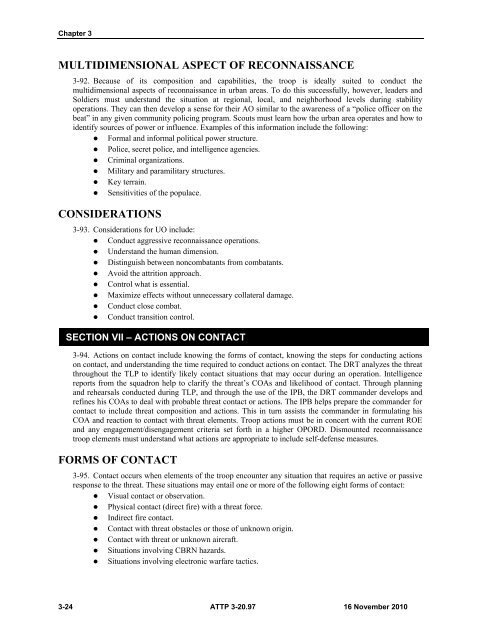Dismounted Reconnaissance Troop - Army Electronic Publications ...
Dismounted Reconnaissance Troop - Army Electronic Publications ...
Dismounted Reconnaissance Troop - Army Electronic Publications ...
Create successful ePaper yourself
Turn your PDF publications into a flip-book with our unique Google optimized e-Paper software.
Chapter 3<br />
MULTIDIMENSIONAL ASPECT OF RECONNAISSANCE<br />
3-92. Because of its composition and capabilities, the troop is ideally suited to conduct the<br />
multidimensional aspects of reconnaissance in urban areas. To do this successfully, however, leaders and<br />
Soldiers must understand the situation at regional, local, and neighborhood levels during stability<br />
operations. They can then develop a sense for their AO similar to the awareness of a “police officer on the<br />
beat” in any given community policing program. Scouts must learn how the urban area operates and how to<br />
identify sources of power or influence. Examples of this information include the following:<br />
Formal and informal political power structure.<br />
Police, secret police, and intelligence agencies.<br />
Criminal organizations.<br />
Military and paramilitary structures.<br />
Key terrain.<br />
Sensitivities of the populace.<br />
CONSIDERATIONS<br />
3-93. Considerations for UO include:<br />
Conduct aggressive reconnaissance operations.<br />
Understand the human dimension.<br />
Distinguish between noncombatants from combatants.<br />
Avoid the attrition approach.<br />
Control what is essential.<br />
Maximize effects without unnecessary collateral damage.<br />
Conduct close combat.<br />
Conduct transition control.<br />
SECTION VII – ACTIONS ON CONTACT<br />
3-94. Actions on contact include knowing the forms of contact, knowing the steps for conducting actions<br />
on contact, and understanding the time required to conduct actions on contact. The DRT analyzes the threat<br />
throughout the TLP to identify likely contact situations that may occur during an operation. Intelligence<br />
reports from the squadron help to clarify the threat’s COAs and likelihood of contact. Through planning<br />
and rehearsals conducted during TLP, and through the use of the IPB, the DRT commander develops and<br />
refines his COAs to deal with probable threat contact or actions. The IPB helps prepare the commander for<br />
contact to include threat composition and actions. This in turn assists the commander in formulating his<br />
COA and reaction to contact with threat elements. <strong>Troop</strong> actions must be in concert with the current ROE<br />
and any engagement/disengagement criteria set forth in a higher OPORD. <strong>Dismounted</strong> reconnaissance<br />
troop elements must understand what actions are appropriate to include self-defense measures.<br />
FORMS OF CONTACT<br />
3-95. Contact occurs when elements of the troop encounter any situation that requires an active or passive<br />
response to the threat. These situations may entail one or more of the following eight forms of contact:<br />
Visual contact or observation.<br />
Physical contact (direct fire) with a threat force.<br />
Indirect fire contact.<br />
Contact with threat obstacles or those of unknown origin.<br />
Contact with threat or unknown aircraft.<br />
Situations involving CBRN hazards.<br />
Situations involving electronic warfare tactics.<br />
3-24 ATTP 3-20.97 16 November 2010

















